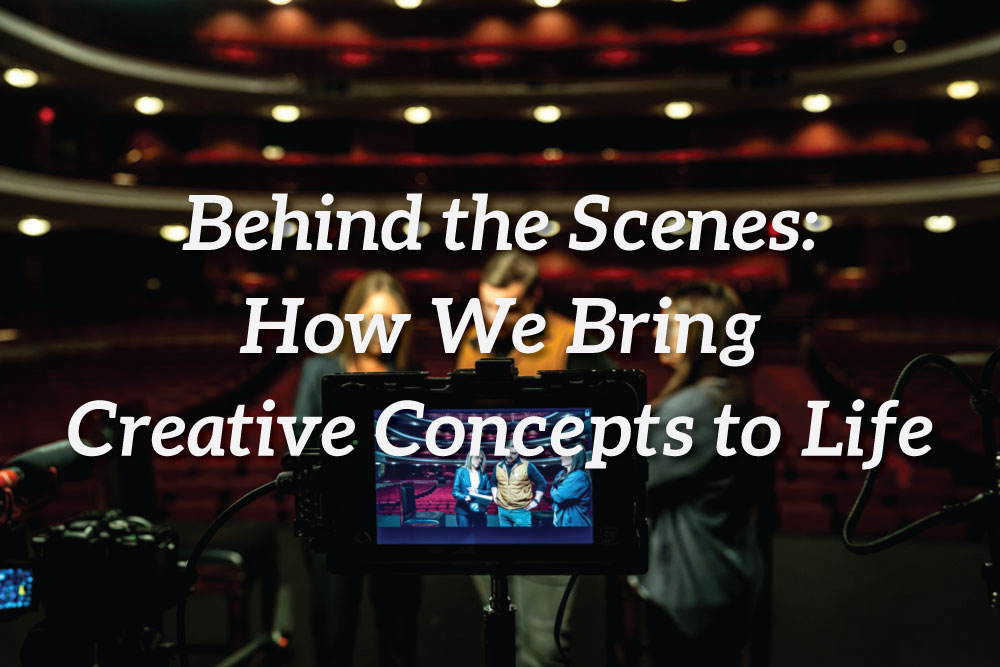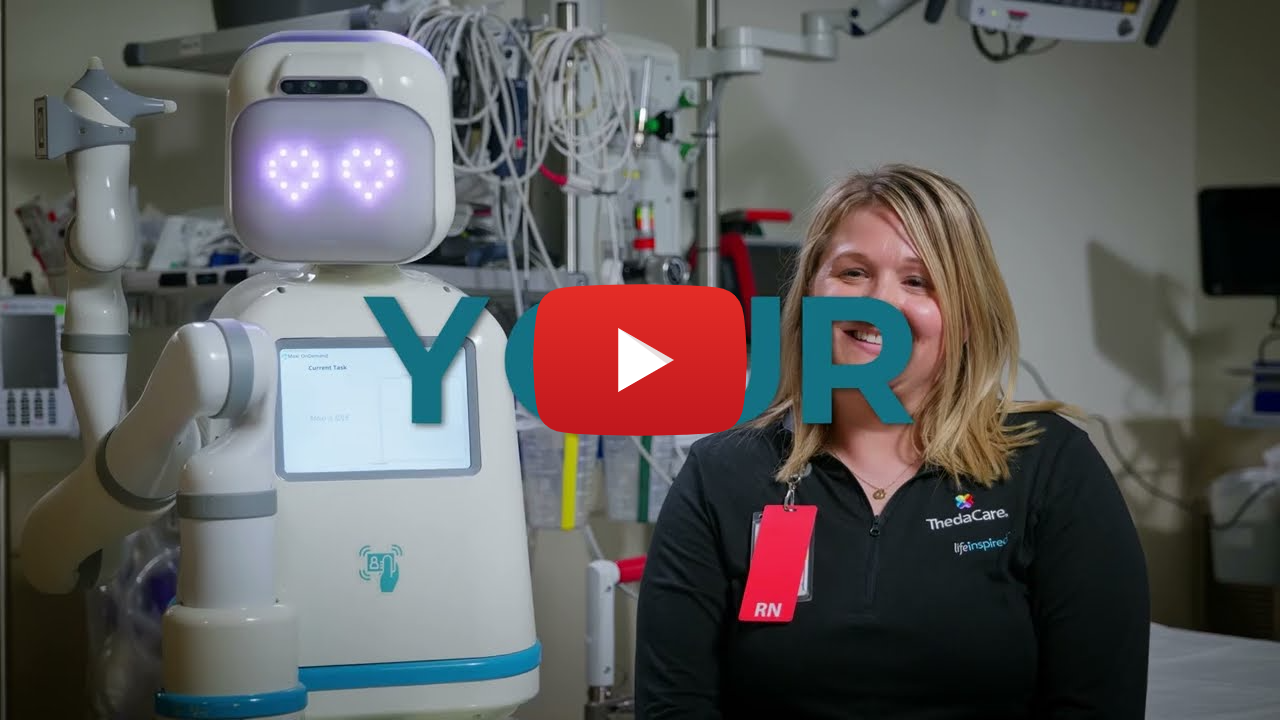Lights! Camera! Action! Uhhhh….line?
If this is your first thought before stepping in front of the camera, don’t worry—you’re in very good company. Whether you’re filming a heartfelt testimonial, answering questions for a documentary, or stepping into a semi-scripted role, the idea of being on camera can feel a little (or a LOT) nerve-wracking. But here’s the good news: you don’t need to be a trained actor to shine on screen.
In fact, testimonial-style videos are often most powerful because they feature real people sharing their real stories. Hearing someone speak from personal experience, in their own voice, is incredibly impactful for viewers. Testimonial videos put a human face on your brand, and even scripted spots feel more genuine when they feature real people (some of our favorites include Theda Care’s Robot Nurse and the Why I Love Oshkosh series).
Almost all of the videos we shoot feature regular folks just like you, and our crew are pros at helping you rehearse, get comfortable, and find your natural rhythm so you feel prepared when the cameras roll.
So, if you’re wondering what to expect, how to rehearse, and how to keep those stage fright jitters under control, you’re in the right place. Let’s get you camera-ready!
What To Expect On Set
Production day can feel like a big deal, and we totally get that. Between the cameras, lights, crew, and all that creative energy buzzing around, it might seem like a lot is going on. But with good pre-production (something we swear by), shoot day is actually much smoother and more straightforward than it looks.
And we have plenty of little tricks up our sleeves to help you feel at ease.
For starters, we’ll often ask the same questions in a few different ways. This isn’t to trip you up—it’s to give you room to explore your answers, warm up naturally, and settle into your groove.
Feeling a bit camera-shy? We can make the camera itself feel less intimidating by taping over the record light so you’re not staring at a blinking “REC” the entire time, or by moving the camera a bit further back and zooming in. That way, it doesn’t feel like there’s a lens practically up your nose.
And if you’d like to see yourself? We can do that too. Whether it’s showing you quick playback after a take or setting up a monitor so you can check your posture or expression, we’ll give you a chance to make adjustments and feel more comfortable.
When it comes to scripts or talking points, we do sometimes use a teleprompter, especially for highly scripted pieces, but for most interviews, we encourage a more conversational feel. That’s because nobody loves that stiff “reading off the screen” look. Keeping it natural is what testimonial-style video is all about.
And here’s a big one: don’t worry if you forget to say something or stumble a bit. Our team is taking notes and will circle back to anything that needs elaboration or clarification. Production is a process, and we’ll make sure you walk away knowing you nailed it.
Nerves Are Normal
Okay, let’s talk about what’s probably really on your mind: “How do I stop being so nervous?!”
First off, let’s make one thing clear—it’s completely normal to feel jittery. Honestly, if you’re not used to being on camera, it’d be weirder if you weren’t a little nervous! Being filmed is outside most people’s comfort zones, but with the right prep, the right mindset, and a supportive crew, we promise it’s nowhere near as scary as it can feel.
A lot of people assume they need to be perfect. They want to look perfect, sound perfect, and never stumble, but that’s putting a lot of pressure on yourself for no good reason. One of the first things we tell all our on-camera talent is three little words: “It isn’t live.” That means we can stop, restart, or do as many takes as you need. Mistakes happen, nerves happen. It’s all part of the process.
We promise that even the most nervous of interviewees can feel like on-camera champs with a little coaching. A great example of this is a shoot we did where we had a younger interviewee for a client video who was really (and we mean really) nervous. Even though we’d met with her beforehand and walked her through everything, once the cameras were rolling, she was tense, stiff, and stumbling over her words. After 20 or 30 minutes, we decided to hit pause, take a breather, and have a casual chat to reset.
For the second go, we switched up the whole vibe. We told her we weren’t rolling (psych! we actually were), had her supervisor and most of the crew leave the room, and moved the cameras further back so they weren’t so in-your-face. We even taped over the record light so there weren’t any distracting red dots blinking at her. The result? She instantly relaxed. Without all the pressure, her real personality came through, and we captured exactly what we needed.
That’s what we do. Our goal is to help you feel like you’re just having a conversation because that’s all an on-camera interview really is.
Check out some of the latest Oshkosh Public Library Brand Launch video to see some interviews in action.
Mastering the Interview Basics
Before we jump in front of the camera, let’s cover a few simple basics that can make a huge difference. Here’s our quick 101 for a great on-camera interview:
Be yourself.
This is our number one tip for all interviewees. The most engaging interviews come from real people, sharing real thoughts. Don’t worry about sounding overly polished. Authenticity is what connects with viewers, so let your personality shine.
Practice beforehand.
Even if you’re not delivering scripted lines, it’s super helpful to practice your thoughts. During pre-production, we’ll give you the questions in advance so you have time to review them. Jot down some bullet points, talk them through with a friend, record a voice memo, or even draft ideas with ChatGPT if that’s your thing. Being prepared doesn’t mean sounding rehearsed; it just means you’ll feel more comfortable knowing what you want to say.
Whatever you say might be used.
During the interview, remember that all of your answers, even the little asides or off-the-cuff remarks, could make it into the final edit. So take a breath before responding, speak thoughtfully, and stay focused on what you want to convey. That way, whatever ends up in the video is something you feel good about.
Be aware of the mic.
Avoid tapping or touching your mic during the shoot. A light pat or fidgeting with your clothes can come through loud and clear on the recording.
Take your time.
We’d much rather do fifteen takes to get a perfect answer than one rushed, shaky version. If it takes an hour to nail a scene, that’s okay! We promise we won’t rush you, so don’t rush yourself.
Keep your wardrobe simple.
When choosing what to wear, stick to comfortable clothes, hair, and make-up that feel like “you,” and opt for simple colors—think neutrals, solids, or bolds. Avoid pastels that can wash you out and busy patterns that can distract on camera. You want your words and your personality to be the focus.
You Got This
Believe it or not, even we don’t always love being in front of the camera either! That’s why we always try to put ourselves in your shoes. Our biggest piece of advice? Take a deep breath, be yourself, and if you trip up, just try again! That’s the beauty of working with a team that understands that authenticity matters more than perfection.
You’re here because you have knowledge, expertise, and a story to tell. So speak from the heart, answer questions honestly, and don’t overthink every little detail. Treat it like a conversation with a trusted friend and do your best to forget the cameras are even there.
And remember, testimonial videos and interviews are one of the most powerful tools to have in your marketing arsenal. They build trust, help you connect with your audience, and show the real people behind your brand.
Ready to share your story? Motion Works Media can help. Whether it’s capturing heartfelt testimonials, expert interviews, or any other kind of video content, we’ll make the process comfortable and the end result something you’re proud of. Get in touch with us today and let’s get rolling!









